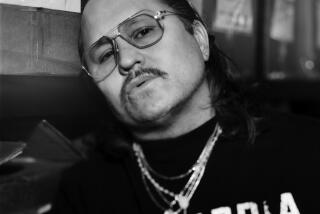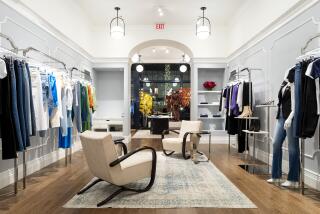HIS FUTURE IS NOW
It’s a cloudless day in L.A., and Nicolas Ghesquiere is showing me around his greenhouse. It’s actually the new Balenciaga store in the pool blue shadow of the Pacific Design Center, but it could well be some otherworldly garden. Here, in this spectacular tinted glass space on Melrose Avenue, the color-daubed dresses and tops from his spring collection hang like hothouse flowers.
“When you drive by at night, it looks like the whole store is blue and moving,” Ghesquiere says, gazing out at the cacti in front of the Space Age meets California Organic building, which he designed with French artist Dominique Gonzalez-Foerster.
For a Parisian, he’s really got this L.A. thing down.
The truth is Ghesquiere, 35, is no stranger to this city, where he has been shooting the Balenciaga ad campaigns for four seasons, holing up at the Bel-Air for a week at a time and planning the store, the second Balenciaga location in the U.S. He even has a list of favorite spots: Matsuhisa, Sunset Tower, the Polo Lounge, Arcana bookstore in Santa Monica.
“I understand why people live here,” he says.
It makes sense that this student of science fiction and the most technically innovative designer of his generation would feel at home in the land of Schindler and Lautner, the special effects capital of the universe, where the lines between faux and real are forever blurred. His work is a fusion of Old World couture and the eternally modernist sensibility that this metropolis represents, of French elegance and casual athleticism.
If you’re wearing a flippy skirt, gladiator sandals, ankle boots or a big, ethnic-print scarf, no matter what label they have inside, you’re wearing them because of Ghesquiere. And come fall, when you’re piling on your mother’s costume jewelry, you’ll have Ghesquiere to thank for that too. Chunky crystal necklace and bracelet sets were all over his show in Paris last month, which was one of the best of the runway season. His most accessible yet, with its austere black dresses and longer hemlines, the fall collection had a mature look that suits the times and broadens Balenciaga’s reach.
This may be the age of Ghesquiere, but when he arrived at Balenciaga a little more than a decade ago, the house had little currency except for a few perfume licenses. Spanish master Cristobal Balenciaga, revered for his sculptural volumes, retired in 1968. The consummate couturier, he refused to do ready-to-wear. And for a while, Ghesquiere mostly expanded on his designs.
In 2001, he launched an “it” bag, the Lariat, with its multiple zippers and stitched handle, that is still a retail hit. But even that couldn’t save the brand from losing money. Ghesquiere and the head of Balenciaga’s parent company, Gucci Group Chief Executive Robert Polet, charted a course toward profitability by creating the Edition line of reissued couture originals, and the Capsule collection of less expensive, runway-inspired pieces, which now forms the bulk of the business. Both are available at the L.A. store, along with menswear.
Ghesquiere has found his own voice, and made Balenciaga the most trend-setting French fashion brand, and the only fashion brand besides Prada that consistently affects every level of the market. Now, he’s aiming to conquer Hollywood, with a staff person to help with celebrity requests -- Nicole Kidman, Jennifer Connelly and the Olsen twins are fans -- and a VIP room that looks like a spaceship. No doubt, the name Ghesquiere -- that’s JESS-scare -- will soon be on everyone’s lips.
What goes around . . .
It’s hard to believe it’s been only six years since the designer hit his lowest point, making headlines for copying a 1974 collage vest by Bay Area artist Kaisik Wong seam-for-seam. Nevermind that he was seasons ahead of the fashion pack, presaging an interest in wearable art that has since made Rodarte shine.
Now, Ghesquiere is himself one of the most copied designers, with lines from the cerebral Proenza Schouler (long, lean jackets, flippy skirts and domed hats from Fall ‘06) to the cheap-chic Zara (ikat scarves and schoolboy blazers from Fall ‘07) “borrowing” from him.
Without elaborate set pieces, he has created some of the most dramatic fashion-as-theater runway moments in recent history -- all at the company’s tiny Left Bank showroom. Ghesquiere is a master at orchestrating excitement. His models move around the runway hurriedly, giving guests barely enough time to take in the multicolored Lego-like plastic shoes, C-3PO metal plate leggings and baroque pants suits. No wonder you always leave wishing you could see the show again.
Which is why, when you meet him, it’s surprising to find that he is completely disarming, the antithesis of a rock star designer. He’s small in stature, but his crystal blue eyes give him presence. What he enjoys most about coming to the U.S., he says, is that women aren’t afraid to approach him. “Here, people come up to you at Barneys and say, ‘I love that you did this,’ or ‘I have your bag.’ I have to say that is really nice.”
Ghesquiere should be humble, because it’s not often a designer lands the top spot at a French fashion house without having ever attended design school, plucked out of the back room where he was designing uniforms for a Japanese licensing partner.
He grew up in Loudun, France, a small town about three hours outside of Paris, where he spent less time on his studies than on his drawings -- fashionable portraits of Marvel comic strip heroes the Fantastic Four and ‘80s icons such as Grace Jones. When he was 15, his father, a golf course manager, helped him send a few sample sketches to Agnes B, and the label took him on for a month during the summer. “In 1987, Paris was the cool place. It was the moment of Jean Paul Gaultier, Claude Montana, Thierry Mugler and Azzedine Alaia. It was the beginning of fashion as pop culture.”
Ghesquiere had barely finished high school when he scored an internship at Gaultier in 1990, then at the cone-bra height of his popularity. “It was about coffee and not much drawing,” he says. “But I was looking at everything . . . I learned that fashion is putting together many, many things, crossing the universe of arts, movies and music.”
“Fashion used to be very subversive,” he says. “Now it’s about brands. If you want a name, you have to build a brand.”
The fall season in Paris saw the beginnings of a backlash against fashion as big business, with a return to minimalism and nary a handbag on the runway.
“There are so many shows, I feel like they are just throwing clothes on the catwalk,” Ghesquiere says. “I’m not naming names, but you think they should edit.”
Ghesquiere has never shown handbags on his runway. He’s too cool for that. But he knows that now that Balenciaga is going global, it’s going to be even harder to stay above the fray. “For me,” he says, “the craft is really what’s making a difference.”
--







